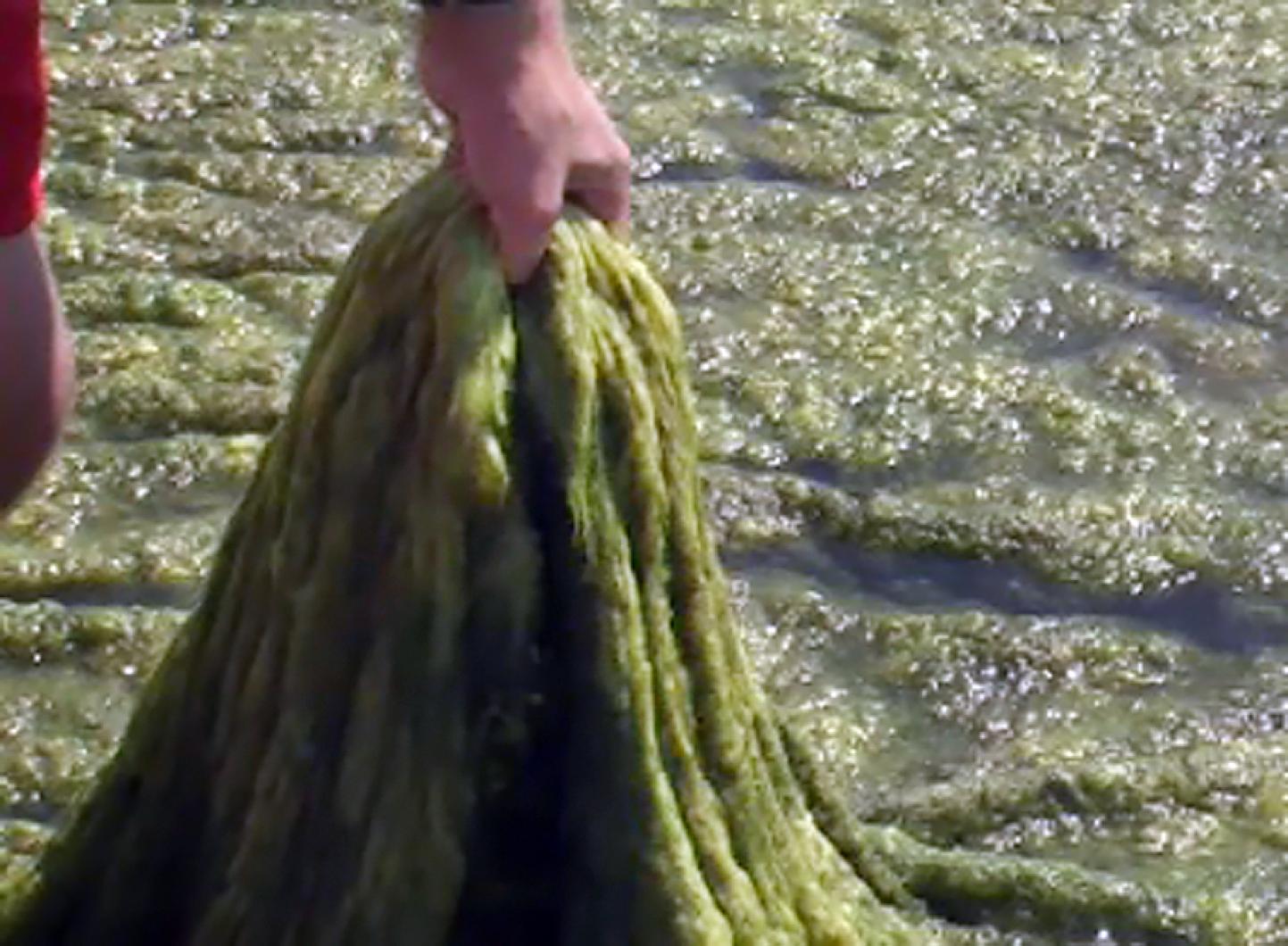Experts are mystified by the bloom of an unknown type of algae this summer on the Edgartown Great Pond that has covered acres of the pond’s surface, choking out light to eelgrass beds and then sinking onto shellfish beds.
A sample of the algae was sent this week to the Smithsonian Institution after attempts to positively identify it through records at the Polly Hill Arboretum and through the Woods Hole Oceanographic Institution were inconclusive.
But while the exact species is unknown, local experts agreed the weed appeared to be of a family which thrives in nitrogen-enriched waters.
Nitrogen pollution has been identified as the greatest threat to the health of Martha’s Vineyard’s ponds. A draft report by the Massachusetts Estuaries Project on the state of the Edgartown Great Pond last year found the total nitrogen input into the pond would have to be cut by at least 30 per cent if the pond was to be restored to good health.
This new bloom, said Bruce Rosinoff, the Martha’s Vineyard estuaries project coordinator, is further evidence of the magnitude of the problem and the urgency of addressing it.
“It’s a form of algae no one is familiar with,” he said. “A sample was sent to Woods Hole, and they’d never seen anything quite like it.
“So we have more questions than answers at this point. It was thick, matted, floating over large areas, mostly in the western part of the pond. It’s been having quite an impact on the pond this summer. A lot of folks with homes on the pond have been complaining of smell from decay. It’s very unsightly,” Mr. Rosinoff said.
More importantly, it presents a threat to other life in the pond.
Bill Wilcox, the water resource planner for the Martha’s Vineyard Commission, said he is concerned about the effects of the weed on eelgrass beds in the pond.
The risk is two-fold: first because the living algae could starve the eelgrass of light, and second because the dying algae could lead to oxygen depletion in the water.
“It’s a filamentous alga; it looks like fine threads under a microscope,” Mr. Wilcox said.
“Tentative IDs put it in a group in the ulva family. That’s one that responds to nitrogen. But we are waiting for an ID from the Smithsonian to know exactly what it is and what we are dealing with,” he said, adding:
“It follows a cycle where it grows heavily through July, then breaks loose and floats to the surface, buoyed by gases released by photosynthesis. Floating mats come onshore and when blown into drifts it can pile up quite densely.
“But most of it sinks to the bottom.
“It’s a cause for some concern because eelgrass had made a good comeback in recent years.
“I saw it at Kanomika. It was pretty heavy in the eelgrass.”
The algae had been present last summer too, Mr. Wilcox said, but is far worse this year. He said the evidence seemed to suggest a generally worse year this year than last, with blooms in other ponds too, although not of the same type.
Workers for the Great Pond Foundation, a nonprofit group committed to stewardship of the pond, had taken to raking up some of the dying algae, Mr. Wilcox said, to try to get the biomass out of the water columns.
They now are considering whether it might be possible to remove greater quantities by mechanical means, and also are beginning tests to see whether the harvested, nitrogen-rich algae could be put to any useful purpose, such as fertilizer.
Rick Karney, shellfish biologist and director of the Martha’s Vineyard Shellfish Group, said an oyster cultivation project at Kanomika Point had been affected by the bloom.
“There was a nasty coating of this stuff over a couple of acres,” he said. “It settled to the bottom in many areas.
“The shells of some of the oysters were black with it. There was evidence of an hypoxic event.”
It was necessary to drag the site to remove much of the algae before a seeding program could begin.
It is yet to be determined if there will be long-term damage to the oysters, Mr. Karney said. Indeed, it could be that oysters might be part of the solution to the problem.
“One reason seeing these bad algal blooms could be because of the low numbers of oysters,” he said. (Almost all the wild oysters in the pond have been wiped out by disease.)
“Oysters filter water, and help remove nitrogen bound up in phytoplankton,” Mr. Karney said.
Whatever the true identity of the mystery algae, and whatever the cause of the sudden population explosion, they provide powerful evidence of the impact of human activity, particularly septic and other nitrogen sources on the Island environment.
The Vineyard Conservation Society is now producing a short movie on the bloom to make that point. Joan Ames, a conservation society board member and professional videographer, filmed the floating mass on August 8 and again on Tuesday this week, for a brief film she hopes to air soon on MVTV.
“It’s weird stuff,” she said. “When you squeeze the water out of it, it feels just like felt.
“Of course, most of it has sunk to the bottom now, turning to black muck, taking more oxygen out of the water.”







Comments (1)
Comments
Comment policy »